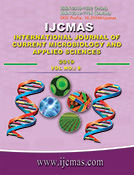


 National Academy of Agricultural Sciences (NAAS)
National Academy of Agricultural Sciences (NAAS)

|
PRINT ISSN : 2319-7692
Online ISSN : 2319-7706 Issues : 12 per year Publisher : Excellent Publishers Email : editorijcmas@gmail.com / submit@ijcmas.com Editor-in-chief: Dr.M.Prakash Index Copernicus ICV 2018: 95.39 NAAS RATING 2020: 5.38 |
The study of heterosis would help in selection of heterotic crosses for commercial exploitation of F1 hybrids in okra (Abelmoschus esculentus (L.) Moench). 45 F1s were developed by crossing 10 elite lines of okra in half diallel fashion during summer 2016. All 45 F1s along with their 10 parents and one standard control (Nunhems hybrid Shakti) were evaluated in a randomized complete block design with three replicates during late kharif (July to October) 2016 at ICAR- Krishi Vigyan Kendra, Babbur Farm, Hiriyur, Chitradurga, Karnataka, India, for heterosis of yield and its components of okra. Significance of mean squares due to genotypes revealed the presence of considerable genetic variability among the material studied for almost all yield and yield attributes. The overall maximum positive significant heterosis for total yield per plant was observed in cross IIHR-875 x IIHR-478 (112.89%) over relative heterosis, (83.78%) over heterobeltiosis and (168.55%) over standard heterosis. Negatively heterotic crosses like IIHR-562 x IIHR-444 for days to 50% flowering (-8.70%) and IIHR-567 x IIHR-107 for fruiting nodes (-9.03%) respectively, are important to exploit heterosis for earliness in okra. Out of 45 F1s, 44 F1s crosses exhibit significant standard heterosis in any given direction for total yield per plant except cross IIHR-604 x IIHR-107 (-0.13%). The F1 hybrid IIHR-875 x IIHR-478 with high yield potential has the potential for commercial cultivation after further evaluation for late kharif season of Karnataka.
 |
 |
 |
 |
 |